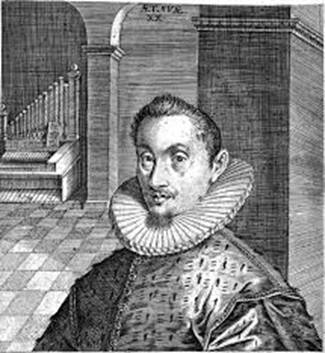The death of Monteverdi’s former employer, the Duke of Mantua, without a natural heir, also in 1627, led to a power struggle and a bitter war in Northern Italy. The political stability of Venice, and her wealth, protected the citizens from the effects of the war; but in 1630 the imperial soldiers, still fighting in the north of Italy, brought with them the bubonic plague. The civic authorities in Venice took stringent quarantine measures, which delayed the disease, but by the autumn the first cases appeared and the disease spread rapidly. Soon nobody would venture out of doors. St Mark’s even forwent the rents on its houses as nobody would go to collect them. Services and music at the basilica were suspended, and all music-making in the city ceased for some months. Every single one of the novices in the monastery SS Giovanni e Paolo died, and the superb choir and orchestra which Monteverdi had built up was largely obliterated by the disease. Monteverdi’s son, Francesco, also a singer in the choir, died. There was a notable reduction in the amount of music published during this time. By November 28th 1631 things must have been returning to normal, however, as the Doge and the Senate held a solemn mass, with new music by Monteverdi, to give thanks for the passing of the plague.
Monteverdi, by now 64, and having returned in some way to writing secular and stage music, had lost much of his appetite for church music. Records show that he did build up the choir again, but the regularity of rehearsals and performances was less than before, and the composition of new sacred music somewhat reduced. Between 1637 and 1641 no fewer than four new opera houses were opened in the city, and composers who had survived the plague, including Monteverdi, seemed more interested in keeping those supplied with new music. Between the start of 1640 and the end of 1641 he produced four complete operas, including The Coronation of Poppea. His sight was starting to fail and he took holy orders. In 1642, amidst failing health, the Procurators granted him a gift of 200 ducats, and six months’ leave. He used this time to visit Cremona and Mantua, the places of his youth, and returned to Venice only to die. He was taken ill on November 20th 1643, and public health records show that he died on November 29th. An obituary by Andrea Camberlotti states:
The Most Illustrious and Reverend D. Claudio Monteverdi, Maestro di Cappella of the church of S. Marco, died aged 73, of malignant fever of nine days’ duration. The news of such a loss upset and turned all the city to sadness and mourning, and was accompanied, not by singing from the choir of singers from St Mark’s, but by their tears and weeping.
He was buried in the Church of the Frari, in the chapel of St Ambrogio, after a requiem with music conducted by his friend and pupil Giovanni Rovetta.
This time the Procurators took a full six months to appoint a successor. Whether this was out of respect, or because they couldn’t find anybody of commensurate calibre, we shall never know. Eventually they promoted Rovetta to the position. By 1700 musical tastes had changed, Monteverdi was forgotten and the Italian musical baton had been passed to Baroque composers such as Vivaldi (1678-1741), Corelli (1653-1713) and Alessandro Scarlatti (1660-1725), who were writing in quite a new style.
Giovanni Picchi (c1571 - 1643)
Giovanni Picchi was born in Venice and by 1615 is recorded as being the organist of the Cà Grande church on the Grand Canal. He was also held in high regard during his lifetime as a lutenist and keyboard player. In 1624 he applied unsuccessfully for the post of second organist at St Mark’s and was still in office at Cà Grande at his death. Picchi only published music for the keyboard, and instrumental music for woodwind, brass and stringed instruments, mostly in the form of canzonas and sonatas. He was the only Venetian composer of this period to write dance music for the harpsichord.
Girolano Frescobaldi (1583 - 1643)
Girolamo Frescobaldi was born in Ferrara in 1583 and became organist of St Peter’s Basilica in Rome in 1628. He had a tremendous reputation as a virtuoso organist, and thirty-thousand people are said to have attended his first performance in Rome. He was a composer of motets and madrigals but his most notable achievements as a composer were his fugues, toccatas, ricecari and capriccios for instruments and the keyboard. He died in Rome, still in office at St Peter’s.
Giovanni Kapsberger (c1580 - 1651)
Giovanni Girolamo Kapsperger (sometimes known as Hieronymus Kapsberger) was the son of a German military colonel, but was born in Venice where he lived until he was 25 years old. He was well-known as a virtuoso on instruments of the lute family, and he published volumes of lute music containing toccatas, galliards and correntes for dancing, as well as books of sacred music, madrigals and villanelles. Moving to Rome in 1605 he quickly ingratiated himself with the Vatican, although attempts to introduce his own works into the repertoire of musicians at the Sistine Chapel were not successful. His flamboyant style as a lutenist was characterised by lively ornamentation, trills, tremolandi and slides.

Claudio Monteverdi